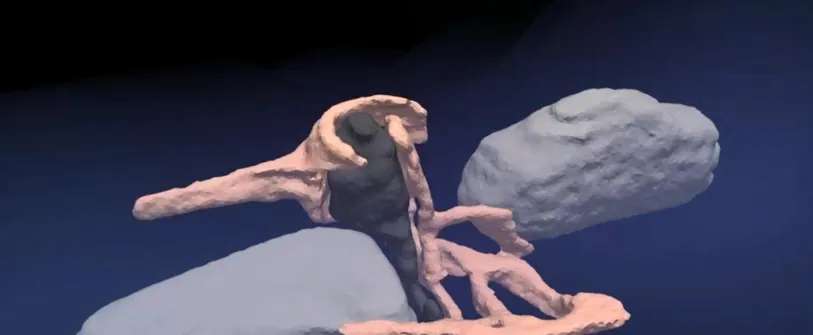
Binary Star System Discovered near Milky Way's Supermassive Black Hole: A Cosmic Revelation!
2024-12-19
Author: Amelia
Groundbreaking Discovery of Binary Star System D9
In a groundbreaking discovery, an international team of astronomers has located a binary star system, dubbed D9, orbiting in the proximity of Sagittarius A*, the supermassive black hole that resides at the heart of our Milky Way galaxy. This marks an unprecedented find as it is the first instance of a stellar pair being found in the harsh gravitational clutches of a supermassive black hole.
The researchers utilized data from the European Southern Observatory's Very Large Telescope (ESO's VLT) to make this discovery, shedding light on the mystery of how stars can persist in such tumultuous environments. The findings not only enhance our understanding of stellar behavior near black holes but also lay the groundwork for future inquiries into potential planet formation in these extreme conditions.
Florian Peißker, a researcher from the University of Cologne, who led the study, mentioned, “Black holes are not as destructive as we thought.” This revelation challenges long-held assumptions about the lethal nature of black holes, showing that there can be a symbiotic relationship where stars, and possibly planets, can coexist.
What Are Binary Stars?
Binary stars are systems comprised of two stars that orbit around a shared center of mass—essentially, they are cosmic dance partners. The stars in these systems can either be extremely close to one another, sometimes sharing material, or they can be situated far apart while still bound by gravity. The study of binary stars is critical as they allow astronomers to accurately gauge stellar masses and understand the dynamics involved in the formation of planetary systems.
D9: A Young Binary Star with an Expiring Future
The newly identified binary star system, D9, is excitingly young, approximately 2.7 million years old. However, its precarious position next to Sagittarius A* implies that the intense gravitational tidal forces will likely lead to its eventual merger into a solitary star within the next million years—a fleeting occurrence in the vast timeline of the universe. “This provides only a brief window on cosmic timescales to observe such a binary system—and we succeeded!” expressed study co-author Emma Bordier.
Revisiting What We Know About Black Holes and Star Formation
Previously, there was a consensus among scientists that the extreme gravitational environments near supermassive black holes inhibited the formation of new stars. Nevertheless, the emergence of several youthful stars near Sagittarius A* over the past few years has led to a reevaluation of this notion. The presence of gaseous materials around D9 further supports the idea that stars can, indeed, form in these turbulent locales.
The discovery was made within the S cluster, a densely populated assembly of stars near Sagittarius A*. Among its most mysterious entities are the so-called G objects, which appear similar to clouds of gas and dust, yet exhibit stellar characteristics.
Confirmation of D9's Binary Nature
Using advanced observational tools, the research team was able to confirm D9's binary nature through velocity variations observed over 15 years. Peißker noted, “It was clear this detection is indeed the first binary observed in the S cluster,” which opens up new avenues of research into the behavior of such systems.
These intriguing findings also encourage speculation regarding the nature of the G objects, which may represent either unmerged binary stars or remnants from stars that have already undergone a merger.
Looking Ahead: The Quest for Planets
While the discovery of D9 is monumental, it raises further questions concerning the objects orbiting near Sagittarius A*. With advancements such as the GRAVITY+ upgrade to the VLT Interferometer and the METIS instrument to be showcased on the upcoming Extremely Large Telescope (ELT) in Chile, astronomers anticipate a revolution in our understanding of the Galactic center.
Peißker concluded with optimism, “Our discovery lets us speculate about the presence of planets, since these are often formed around young stars. It seems plausible that the detection of planets in the Galactic center is just a matter of time.”
This discovery not only enhances our understanding of binary stars but also opens thrilling possibilities for future discoveries in one of the most extreme environments in our galaxy. How many more secrets does the cosmos hold? The answer awaits as science continues its quest among the stars!









 Brasil (PT)
Brasil (PT)
 Canada (EN)
Canada (EN)
 Chile (ES)
Chile (ES)
 España (ES)
España (ES)
 France (FR)
France (FR)
 Hong Kong (EN)
Hong Kong (EN)
 Italia (IT)
Italia (IT)
 日本 (JA)
日本 (JA)
 Magyarország (HU)
Magyarország (HU)
 Norge (NO)
Norge (NO)
 Polska (PL)
Polska (PL)
 Schweiz (DE)
Schweiz (DE)
 Singapore (EN)
Singapore (EN)
 Sverige (SV)
Sverige (SV)
 Suomi (FI)
Suomi (FI)
 Türkiye (TR)
Türkiye (TR)